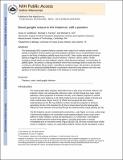| dc.contributor.author | Goldberg, Jesse H. | |
| dc.contributor.author | Farries, Michael A. | |
| dc.contributor.author | Fee, Michale S. | |
| dc.date.accessioned | 2016-05-04T23:41:53Z | |
| dc.date.available | 2016-05-04T23:41:53Z | |
| dc.date.issued | 2013-11 | |
| dc.identifier.issn | 01662236 | |
| dc.identifier.uri | http://hdl.handle.net/1721.1/102409 | |
| dc.description.abstract | The basal ganglia (BG)-recipient thalamus controls motor output but it remains unclear how its activity is regulated. Several studies report that thalamic activation occurs via disinhibition during pauses in the firing of inhibitory pallidal inputs from the BG. Other studies indicate that thalamic spiking is triggered by pallidal inputs via post-inhibitory ‘rebound’ calcium spikes. Finally excitatory cortical inputs can drive thalamic activity, which becomes entrained, or time-locked, to pallidal spikes. We present a unifying framework where these seemingly distinct results arise from a continuum of thalamic firing ‘modes’ controlled by excitatory inputs. We provide a mechanistic explanation for paradoxical pallidothalamic coactivations observed during behavior that raises new questions about what information is integrated in the thalamus to control behavior. | en_US |
| dc.description.sponsorship | National Institutes of Health (U.S.) (Grant R01DC009183) | en_US |
| dc.description.sponsorship | National Institutes of Health (U.S.) (Grant K99NS067062) | en_US |
| dc.language.iso | en_US | |
| dc.publisher | Elsevier | en_US |
| dc.relation.isversionof | http://dx.doi.org/10.1016/j.tins.2013.09.001 | en_US |
| dc.rights | Creative Commons Attribution-NonCommercial-NoDerivs License | en_US |
| dc.rights.uri | http://creativecommons.org/licenses/by-nc-nd/4.0/ | en_US |
| dc.source | PMC | en_US |
| dc.title | Basal ganglia output to the thalamus: still a paradox | en_US |
| dc.type | Article | en_US |
| dc.identifier.citation | Goldberg, Jesse H., Michael A. Farries, and Michale S. Fee. “Basal Ganglia Output to the Thalamus: Still a Paradox.” Trends in Neurosciences 36, no. 12 (December 2013): 695–705. | en_US |
| dc.contributor.department | Massachusetts Institute of Technology. Department of Brain and Cognitive Sciences | en_US |
| dc.contributor.department | McGovern Institute for Brain Research at MIT | en_US |
| dc.contributor.mitauthor | Goldberg, Jesse H. | en_US |
| dc.contributor.mitauthor | Fee, Michale S. | en_US |
| dc.relation.journal | Trends in Neurosciences | en_US |
| dc.eprint.version | Author's final manuscript | en_US |
| dc.type.uri | http://purl.org/eprint/type/JournalArticle | en_US |
| eprint.status | http://purl.org/eprint/status/PeerReviewed | en_US |
| dspace.orderedauthors | Goldberg, Jesse H.; Farries, Michael A.; Fee, Michale S. | en_US |
| dc.identifier.orcid | https://orcid.org/0000-0001-7539-1745 | |
| mit.license | PUBLISHER_CC | en_US |
